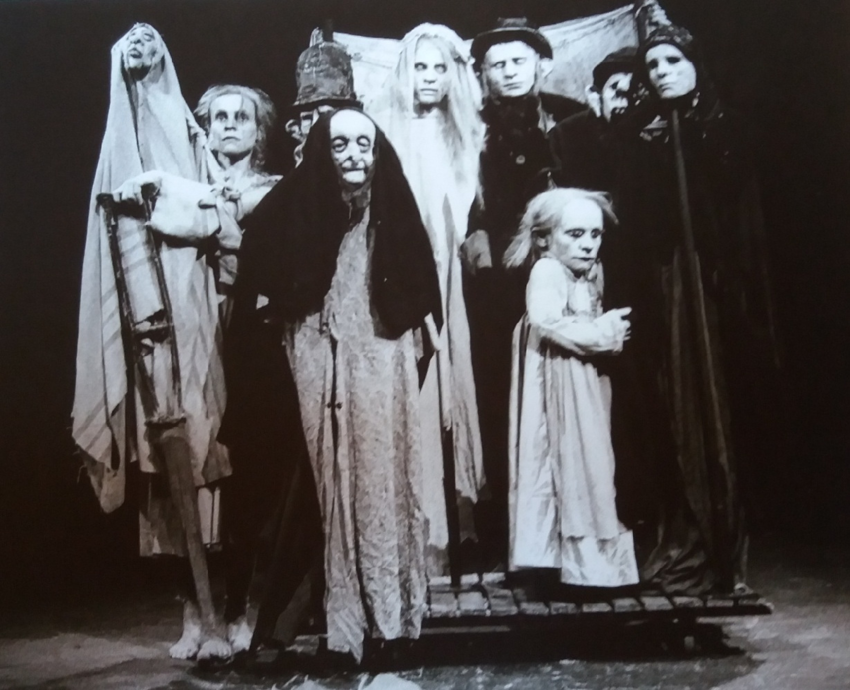Ana Wegner, editor for scientific popularisation of the Revista Brasileira de Estudos da Presença, CAPES/Université d’Artois, Arras, IDF, France.
In its 15 years of existence, the Revista Brasileira de Estudos da Presença published some thematic sections focusing on specific artistic languages, such as Problems With Cinema, Problems With Research (vol. 14, issue. 1, 2024), Dance: History and Historiography (vol. 12, issue. 1, 2022) and Performance and Animated Forms (vol. 12, issue. 3, 2022). The latter, edited by Rossana Della Costa and Fabiana Marcello, includes a range of animated forms in popular cultures and contemporary scenes, which are approached aesthetically, politically or historically.
From this compendium, we highlight Images as Apparitions of the Body: Ilka Schönbein’s loving game, an article written by Thais Helena D’Abronzoa, which analyses the career of Ilka Schönbein, a German puppeteer and dancer, emphasizing how the hybridization between dance and the manipulation of animated forms challenges the perception of the body. The study is derived from the author’s PhD thesis (D’ABRONZO, 2019) on Schönbein and her company Theater Meschugge (“Crazy Theatre” in Ydish). The specific section adopted in the article is permeated by a solid knowledge of both the theater of forms and the artist and her context.
The term “game” in the title of the article becomes polysemic, encompassing the relationship between the manipulator and their object, the parallels between vital and funereal processes, as well as the hybridization of puppetry and dance. Much more than introducing Portuguese-speaking readers to Schönbein’s work, the author draws on the poetic singularity of the case analyzed to think about animated forms in their possibilities of metamorphosis, friction or symbiosis between the materials of the living body on stage and the animated objects – which, in Schönbein’s case, create effects of disturbing strangeness and/or eroticism.
Schönbein’s biography is traced throughout the text, providing keys to understanding the poetics of this German artist born in 1958: the post-war imaginary, the influence of Ydish music, language and culture, as well as the itinerancy that marks the artist’s creative process (from her native Darmstadt, Ilka travels Europe in a caravan that serves as her accommodation and studio, enabling her to create, refine and present her shows at each stop).
Describing scenes from different works, such as Metamorphose (1993), Die Alte und das Biest – für meinen Vater [The old woman and the beast – to my father] (2009), D’Abronzoa manages to make the reader imagine the power of the images produced in the shows. Two strong images present in the text create counterpoints that intertwine: the drive for life and the relationship with death. In fact, by situating the language that goes from Edward Gordon Craig (sacred body of statues) to Tadeusz Kantor (mannequin-defunct) in the reflection on death that puppetry can induce, the author demonstrates the specificity of Schönbein’s creative process in the making of his puppets, which start from molds of his own body – legs, torso, buttocks, etc. – and sometimes take the form of a death mask. When the puppets return to Ilka’s body in the manipulation of animated forms, spaces of successive metamorphoses are created in the confusion and inversion between one body and another(s), according to the author, creating images beyond the human.
This exploration of the body also leads Ilka Schönbein to repeatedly explore images of vital processes, such as childbirth. The dimension of eroticism can be associated with this drive for life. When the author goes specifically into this area, she analyses them based on the idea of transgressive movements of eroticism by George Bataille (2015) and Georges Didi-Huberman (2018).
The article thus makes us travel through concrete and imaginary territories, awakening the desire to get to know Schönbein’s work better. We therefore invite you to read the thematic section and the article in full, and to watch extracts from performances by Ilka Schönbein.
In the following video, Della Costa goes into more detail about the thematic sections “Performance and Animated Forms”.
References
BATAILLE, G. Documents. MORAES, M.J. and PENNA, J.C. (Trad.). Florianópolis: Cultura e Barbárie, 2018.
D’ABRONZO, T. Imagens para rasgar adultos: a morte e o jogo erótico de Ilka Schönbein [online]. Repositório da Produção Científica e Intelectual da Universidade Estadual de Campinas. 2019 [viewed 04 September 2024]. https://doi.org/10.47749/T/UNICAMP.2019.1127114. Available from: https://hdl.handle.net/20.500.12733/1638433
DIDI-HUBERMAN, G. A Semelhança informe ou o gaio saber visual Segundo Georges Bataille. MEIRA, C. and SCHEIB, F. (Trad.). MORAES, M.J. (Rev. Téc.) Rio de Janeiro: Contraponto, 2015.
To read the article, access
D’ABRONZO, T.H. Imagens como Aparição do Corpo: o jogo amoroso de Ilka Schönbein. Revista Brasileira de Estudos da Presença [online]. 2022, vol. 12, no. 3, e118932 [viewed 04 September 2024]. https://doi.org/10.1590/2237-2660118932vs01. Available from: https://www.scielo.br/j/rbep/a/MpjtZwRV8yRsw5Vv95jYvZm/
External links
Revista Brasileira de Estudo da Presença – RBEP: www.scielo.br/rbep
Revista Brasileira de Estudos da Presença – Site: https://www.seer.ufrgs.br/presenca
Revista Brasileira de Estudos da Presença – Social Media: Facebook | Instagram
Theater Meschugge: http://theatermeschugge.com/
Translated from the original in Portuguese by the author.
Como citar este post [ISO 690/2010]:




















Recent Comments